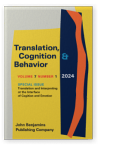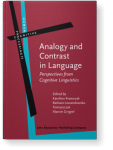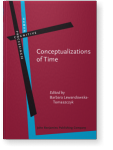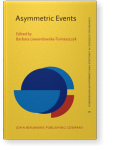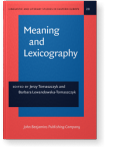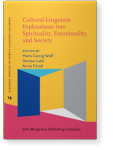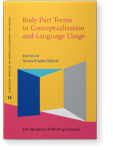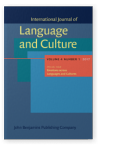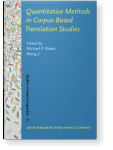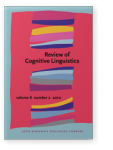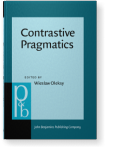Barbara Lewandowska-Tomaszczyk
List of John Benjamins publications for which Barbara Lewandowska-Tomaszczyk plays a role.
Journal
Analogy and Contrast in Language: Perspectives from Cognitive Linguistics
Edited by Karolina Krawczak, Barbara Lewandowska-Tomaszczyk and Marcin Grygiel
[Human Cognitive Processing, 73] 2022. xi, 442 pp.
Subjects Cognition and language | Cognitive linguistics | Theoretical linguistics
Conceptualizations of Time
Edited by Barbara Lewandowska-Tomaszczyk
[Human Cognitive Processing, 52] 2016. xxi, 325 pp.
Subjects Cognition and language | Cognitive linguistics | Semantics | Syntax | Theoretical linguistics
Asymmetric Events
Edited by Barbara Lewandowska-Tomaszczyk
[Converging Evidence in Language and Communication Research, 11] 2008. xii, 287 pp.
Subjects Semantics | Syntax | Theoretical linguistics
Meaning and Lexicography
Edited by Jerzy Tomaszczyk and Barbara Lewandowska-Tomaszczyk
[Linguistic and Literary Studies in Eastern Europe, 28] 1990. xxv, 340 pp.
Subjects Lexicography | Semantics
2022 Introduction: Analogy and contrast in language: Theoretical and empirical insights from Cognitive Linguistics Analogy and Contrast in Language: Perspectives from Cognitive Linguistics, Krawczak, Karolina, Barbara Lewandowska-Tomaszczyk and Marcin Grygiel (eds.), pp. 1–12 | Chapter
2022 Chapter 13. Contrasts and analogies in cluster categories of emotion concepts in monolingual and cross-linguistic contexts: contempt Analogy and Contrast in Language: Perspectives from Cognitive Linguistics, Krawczak, Karolina, Barbara Lewandowska-Tomaszczyk and Marcin Grygiel (eds.), pp. 405–438 | Chapter
The chapter focuses on the similarities and contrasts in the nature, function and cognitive semantic description of British English versus Polish moral emotion cluster concepts in their contrastive and translational contexts, particularly of contempt and its relationship with disgust and anger.… read more
2021 Cross-cultural models of mental hurt emotion clusters Cultural-Linguistic Explorations into Spirituality, Emotionality, and Society, Wolf, Hans-Georg, Denisa Latić and Anna Finzel (eds.), pp. 123–148 | Chapter
The main objective of this chapter is to construct models of conceptualizations of mental hurt emotional clusters in a cross-cultural perspective, taking British English and Polish as the major areas of investigation. The materials and sources of the data are the GRID instrument, the online… read more
2020 Culture-driven emotional profiles and online discourse extremism Hate speech: Definitions, interpretations and practices, Baider, Fabienne H., Sharon Millar and Stavros Assimakopoulos (eds.), pp. 261–290 | Article
Discourse practices are investigated in English and Polish online comments which display different degrees of linguistic extremism. The present contribution identifies the contexts and targets of such practices and argues that hate speech is conditioned by culture-driven emotional experience and… read more
2020 Polysemic chains, body parts and embodiment Body Part Terms in Conceptualization and Language Usage, Kraska-Szlenk, Iwona (ed.), pp. 31–52 | Chapter
The paper focuses on the phenomenon of embodiment via the perspective of meaning approximation, and re-conceptualization in terms of body-part polysemic chains of conceptualization via dynamically constructed categories. In the first part the analysis focuses primarily on the processes in which… read more
2017 Identity, emotions and cultural differences in English and Polish online comments Emotions across Languages and Cultures, Athanasiadou, Angeliki and Ad Foolen (eds.), pp. 47–72 | Article
The focus of the present paper is to examine the extent to which the language used in Computer-Mediated Communication (CMC) and online discourse emotional behavior are good predictors of individual and group cultural types and their identities. It is argued that the identity marking CMC… read more
2016 Introduction: Introducing Conceptualizations of Time Conceptualizations of Time, Lewandowska-Tomaszczyk, Barbara (ed.), pp. ix–xxii | Article
2012 Explicit and tacit: An interplay of the quantitative and qualitative approaches to translation Quantitative Methods in Corpus-Based Translation Studies: A practical guide to descriptive translation research, Oakes, Michael P. and Meng Ji (eds.), pp. 3–34 | Article
The aim of the present chapter is to evaluate the extent to which quantitative and qualitative methodologies used in translation studies interplay and what new insights are obtained as a consequence of investigating explicit corpus-based data with a more tacit semantic enquiry. The approach used is… read more
2010 A contrastive perspective on emotions: surprise Review of Cognitive Linguistics 8:2, pp. 321–350 | Article
The objective of the present paper is a comparison of the GRID questionnaire and a cognitive corpus-based analysis, which are used to investigate a selection of emotions, particularly surprise and related concepts, in Polish and British English. The research questions asked concern the… read more
2008 14. Asymmetries in participial modification Asymmetric Events, Lewandowska-Tomaszczyk, Barbara (ed.), pp. 261–281 | Article
The paper focuses on differences in the construal relations between participial constructions as used postnominally and prenominally in English and Polish. Their meaning is taken to be a function of both conceptual content of an expression and its construal. It is assumed that construal principles… read more
1990 Meaning, synonymy, and the dictionary Meaning and Lexicography, Tomaszczyk, Jerzy and Barbara Lewandowska-Tomaszczyk (eds.), pp. 181–208 | Article
1990 Introduction Meaning and Lexicography, Tomaszczyk, Jerzy and Barbara Lewandowska-Tomaszczyk (eds.), pp. xi–xxv | Miscellaneous
1989 Praising and complimenting Contrastive Pragmatics, Oleksy, Wieslaw (ed.), pp. 73–100 | Article
